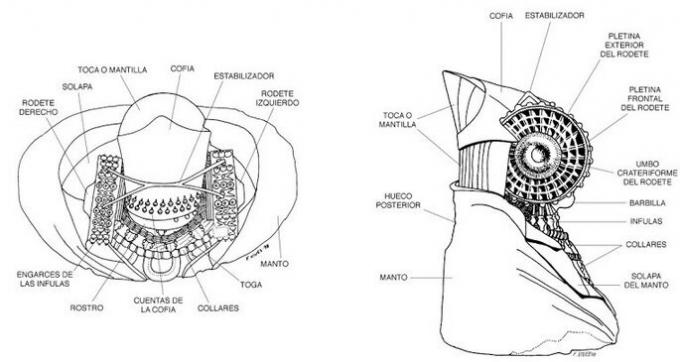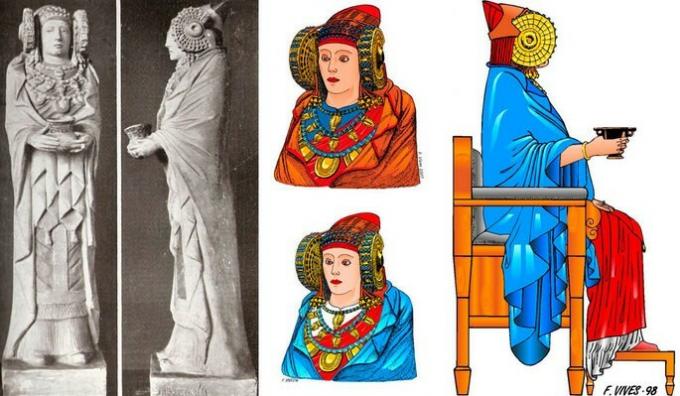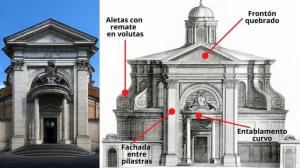The Lady of Elche: history, characteristics and meaning
The Lady of Elche It is an Iberian sculpture dating from the 5th and 4th centuries BC. C. It was found "by chance" at the La Alcudia site, in the Elche region, Alicante (Spain), at the end of the 19th century.

According to Ricardo Olmos, in the brochure The Lady of Elche: figure and symbol, published by the Fundación Universitaria de Investigación Arqueológica La Alcudia de Elche in 2006, the discovery of the piece "confirmed, for example, the existence of an Iberian culture."
That "chance", together with the beauty and uniqueness of the sculptural piece that would demonstrate a firm and autonomous culture, would make it a symbol for the people of Elche and Spaniards in general and, in a way, a symbol of beauty and elegance female. Let us know its most important aesthetic characteristics as well as the very interesting history of its discovery.
Characteristics of the Lady of Elche

The Lady of Elche It is a bust sculpted in porous limestone. It has a height of 56 cm, a width of 45 cm, and a depth of 37 cm. Her weight reaches 65.08 kg. Originally, the sculpture was polychrome, which is evidenced by some red, white and blue markings that endured over time.
From an iconographic point of view, the sculpture represents a richly dressed woman. The Lady she wears three garments: a tunic, a dress (or toga) and, over this, a cloak open in lapels.
On the one hand, it highlights the serenity and idealization of her face. Her features are fine: a slender nose, thin lips, rounded chin, high eyebrows and slanted eyes, which must have been inlaid or colored hollows.
On the other hand, the serenity and expressive restraint of her face contrasts with the detail and exuberance of the ornaments worn by the woman, which are undoubtedly the center of attention.

Two large buns frame her face. These have decorative motifs in the shape of a lotus flower and pearls. In this regard, Ramos Fernández, in the brochure The Lady of Elche: figure and symbol, comments that:
They are cases of braided hair that force her face to show frontally and thus always faces those who contemplate it, with a frontality that could be an indication of an iconography symbolic.
Between the buns and the face of her, hang a few pretenses finished with amphorales. The Lady It is crowned with a cap with beads and a veil that unites, in some way, both buns in a single set.
The dress or gown of the Lady It is adjusted to the neck by means of a fibula or clasp. On the dress she also wears three necklaces with pendants: two of them with amphoras and one with a kind of barbs, probably a charm holder.
But one fact is obvious: on the back of the Lady, there is a cavity 16 cm deep and 18 cm in diameter. What would I be there for? What is your function? What is its meaning?
Meaning and function of Lady of Elche

The sculpture that concerns us, be it from the aesthetic, symbolic or functional point of view, responds to a specific space-time context. It is framed in the full Iberian era, which covers the period that goes from the 5th to the 4th century BC. C. It can be known, roughly, that this culture receives the Phoenician and Greek influence, typical of the Mediterranean area.
The Lady of Elche It was found in unique conditions compared to other sculptures from the same site. He was inside a niche, a kind of niche. This means that the sculpture was deliberately hidden, perhaps in order to protect it from danger.

Therefore, the Lady of Elche, like other adjacent sculptures, was out of context at the time of its discovery (an example of context could be that it was in a temple), which makes it difficult to reach a definitive conclusion about its meaning and function.
The luxurious ornamentation of the portrayed woman made the people of Elche think, at first, that she could be a queen. Soon some professionals banished this idea and suggested the hypothesis that she Lady was originally located in a heroon, a kind of sanctuary dedicated to the worship of a deity or the glories of a hero. It could, therefore, be a deity.

Other researchers think that the role of Lady of Elche she would be a funeral home, by virtue of the cavity she possesses in the back of her. For his part, Ramos Fernández thinks that, given its dimensions, this cavity would only have to be a “deposit of some offering or container of some talismanic object”.
In an article titled "The Lady of Elche and the other Iberian ladies ", available in the aforementioned brochure, the researcher Carmen Aranegui Gascó stops to analyze the Lady in her condition of "lady". Indeed, the Lady of Elche It is not the only female representation in the Iberian context to which it belongs (see previous illustration, example of Lady of Guardamar).

Certain tombs in Andalusia and the SE peninsular house ladies where previous generations had exhibited bulls, lions, warriors or horsemen, indicating a renewal of the imaginary spread by different regions that will also share the type of the offering lady in the sanctuaries that gain strength in the Iberian Plenary (centuries IV-III a. C.). The representation of a woman dressed according to tradition and sumptuously jeweled encourages the cohesion of the dominant group that is now recognized in the family lineage, in a similar way to what was noticed both in Greece and in various cultures italics.
By relating the sculpture to other similar female representations, the researcher constructs the hypothesis of a possible context that values the feminine, while verifying a change in the mentality of the culture Iberian. However, it remains unanswered whether this woman was an allegory to femininity, or a goddess, a priestess, a queen or a praying woman.
See also Analysis of the sculpture Victory of Samothrace.
Hypothetical reconstructions

The various interpretations of the function and symbolism of the Lady of Elche they have given rise to more than one reconstruction exercise. Some researchers think that Lady could have been part of a sculpture of whole body. However, Rafael Ramos Fernández maintains that:
... the traces of the alcotana that it conserves at its base indicate a unique direction of cutting and it is not possible to cut a piece of round lump by applying the tool in only one direction since said cut should be peripheral and radial, from outside to inside, a fact that is not observed in this work and that it shows that the sculptor did not work the basal area of the bust, he did not work the support area of the stone block that served him for his realization.
Thus, Ramos Rodríguez justifies the idea that the Lady of Elche was conceived as we find it: as a female bust.
In any case, what we do have certainty is that the piece was polychrome, as was the custom in those years.
See also Venus de Milo sculpture.
Finding and tour of the Lady of Elche
The history of the discovery of the Lady of Elche it has become part of the piece's appeal, along with its historical and cultural value. For this reason, we bring here the most emblematic events of its discovery and the process that brought it back to Spain.
The unexpected find of a "Moorish queen"
The Lady of Elche was found by a young man named Manuel Campello Esclapez on August 4, 1897. The young man would then be about 18 years old according to his birth certificate, however, he always insisted that he was 14 years old when he discovered the sculpture.
The truth is that the young Manuel found the piece by chance when, after bringing water to the workers of the Finca La Alcudia, owned by Manuel Campello Antón, took the pick and began to hit the ground to entertain yourself.
Feeling a rigid surface, Campello Esclapez continued digging, and found the Lady of Elche, that she was protected inside a niche. Although the young man did not cause havoc, the pecks left slight marks on the sculpture.
The news spread quickly. The people baptized it as the “Blackberry Queen”And many were doing their best to see it. The Lady of Elche she emerged from the earth to become a symbol of that region.
Sold to the Louvre Museum
In the text The Lady of Elche in 2000. Analysis, technological and artistic, Francisco Vives clarifies that the owner of the farm, Don Manuel Campello Antón, soon met with Don Pedro Ibarra who, amazed, made the valuable discovery known through letters inside and outside the country. The sculpture was offered to the National Archaeological Museum in Spain.
While Campello Antón awaited a response from the museum, the city received a visit from Mr. Pierre Paris at the invitation of Don Pedro Ibarra Ruíz. The intention was to attend the famous sacred-lyrical drama Mystery of Elche, but the occasion allowed him to discover another "mystery": the magnificent Lady of Elche. Sooner rather than later, Campello Antón received an offer from Mr. Pierre Paris, who had recommended its acquisition to the Louvre Museum.
Meanwhile, the response from the National Archaeological Museum could not have been more disappointing. The Spanish museum was not interested in the piece. Disgruntled by this and other unfulfilled commitments, Campello Antón sold the work to Pierre Paris for 4000 francs. The sale was not only unpopular, but the people of Elche unfairly held Don Pedro Ibarra Ruíz responsible for having exposed the work to the French Hispanist.
As planned, Paris delivered the work to the Louvre in the same year, 1897. The hitherto "Moorish queen" would have a new "residence". At the Louvre Museum, on the initiative of S. Reinach, the work received the name of the Lady of Elche. The name "lady" was a gesture of erudition that, according to Carmen Aranegui Gascó, functioned as a secular alternative to the classic names of Venus, korai, goddesses or queens.
In 1939, the Second World War forced the mobilization of part of the museum's collection to protect it. The Lady of Elche he ended up at the castle of Montauban on the outskirts of Toulouse. It took until 1941 for the opportunity to be given to return her "home."
Back to spain
Concern for a possible alliance between Spain and the Axis Powers (Italy and Germany), made the French government agree to return some Spanish pieces purchased or looted. On his part, Francisco Franco wanted to guarantee that, in the event of a possible defeat for France, the pieces would not be considered spoils of war by his enemies.
It was thus that General Philippe Pétain and Franco agreed on a exchange that will settle any future doubts about the right of possession of the pieces. According to Francisco Vives, Spain would hand over other works in exchange and would renew to the French the concession on the French Academy located in Madrid, commonly called the Velázquez House.
The Lady of Elche returned by train that year, 1941, accompanied by the Immaculate Conception of Murillo and another nine tons of pieces. It was a gesture by France to guarantee, at least, the neutrality of Spain in the Second World War. After a brief stopover in Barcelona, the sculpture's first destination was the Prado Museum. For a long time, the return of the Lady of Elche it was read as a triumph of the Franco regime.
The reunion of the "discoverer" with the Lady

In 1959, Manuel Campello Esclapez I would see the beautiful again Lady that turned him into a legend, whom he had not seen since the happy discovery. The moment took place at the Prado Museum in Madrid.
A few years later, the museum agreed to bring to the Lady visiting Elche. There, on October 24, 1965, Manuel Campello, now in his eighties, would see the sculpture for the last time. This would be the moment when, finally, the finding of her would be acknowledged and the order of Knight of the Royal Order of Alfonso X the Wise. Two months later, she passed away.
The definitive house of the Lady of Elche
The Lady of Elche It remained in the Prado Museum until 1971, when it was transferred to the Archeology Museum Nacional, the same museum that one day wasted the opportunity to host this treasure of culture Iberian.
In 2006, the Museum consented that the piece be exhibited temporarily in its city of origin, Elche.
SOURCES CONSULTED
ARANEGUI GASCÓ, Carmen: "The Lady of Elche and the other Iberian ladies" in The Lady of Elche: figure and symbol (user information). Elche: La Alcudia de Elche Archaeological Research Foundation. 2006.
THE WORLD IS. "The Lady of Elche returns to the city where she was found for a temporary exhibition" in The world, May 17, 2006.
OLMOS, Ricardo: "And the Lady made up her face" in The Lady of Elche: figure and symbol (user information). Elche: La Alcudia de Elche Archaeological Research Foundation. 2006.
RAMOS FERNÁNDEZ, Rafael: "The Lady of Elche, her history and her impact on the media" in The Lady of Elche: figure and symbol (user information). Elche: La Alcudia de Elche Archaeological Research Foundation. 2006. .
FNFF DRAFTING: "Franco brought the Lady of Elche to Spain" in Francisco Franco National Foundation (official website). February 8, 2019.
NO AUTHOR. "When Spain deceived France: the return of the Lady of Elche" in The Gazette, February 19, 2016.
VIVES, Francisco. The lady of Elche in the year 2000. Technological and artistic analysis. Valencia: Tilde. 2000.
VV.AA. The Lady of Elche: figure and symbol (user information). Elche: La Alcudia de Elche Archaeological Research Foundation. 2006.



